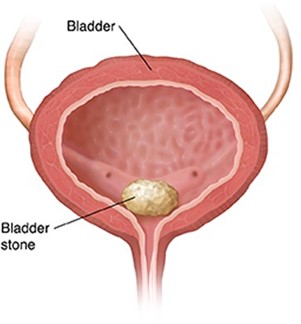Examination of a client's bladder stones reveals that they are primarily composed of uric acid. The nurse would expect to provide the client with which type of diet?
Low oxalate.
Low purine.
High sodium.
High protein.
The Correct Answer is B
Low purine. Uric acid stones may form due to high levels of uric acid in the urine. A low purine diet that restricts meat, seafood, and alcohol may help to reduce uric acid levels in the body.

Option A: Low oxalate is not a correct answer as it is a diet recommended for those with calcium oxalate stones.
Option C: High sodium is not a correct answer as it may increase the risk of kidney stones by increasing urinary calcium excretion.
Option D: High protein is not a correct answer as it may increase the risk of kidney stones due to increased urinary excretion of calcium, oxalate, and uric acid.
Nursing Test Bank
Naxlex Comprehensive Predictor Exams
Related Questions
Correct Answer is B
Explanation
In the Rinne test, the nurse first places a tuning fork on the mastoid process behind the ear, and when the client states that the sound is no longer heard, the tuning fork is placed beside the ear. This test is done to compare bone conduction with air conduction. When sound is no longer heard via bone conduction, the sound will still be heard via air conduction.
Choice A is incorrect because it describes the Weber test, not the Rinne test.
Choice C is incorrect because it is not a standard hearing test.
Choice D is incorrect because it describes the Whisper test, which is also used to test for hearing loss.
Correct Answer is A
Explanation
Change in bowel habits. Change in bowel habits, such as diarrhea, constipation, or a change in stool consistency, is a common early symptom of colon cancer. The nurse should advise clients over age 50 to report any changes in bowel habits to their primary care provider for early intervention.
Choice B is incorrect because abdominal cramping is a common symptom of irritable bowel syndrome and not necessarily an early symptom of colon cancer.
Choice C is incorrect because daily bowel movements are considered normal for some individuals and are not necessarily indicative of colon cancer.
Choice D is incorrect because excess gas is not an early symptom of colon cancer.
Whether you are a student looking to ace your exams or a practicing nurse seeking to enhance your expertise , our nursing education contents will empower you with the confidence and competence to make a difference in the lives of patients and become a respected leader in the healthcare field.
Visit Naxlex, invest in your future and unlock endless possibilities with our unparalleled nursing education contents today
Report Wrong Answer on the Current Question
Do you disagree with the answer? If yes, what is your expected answer? Explain.
Kindly be descriptive with the issue you are facing.
